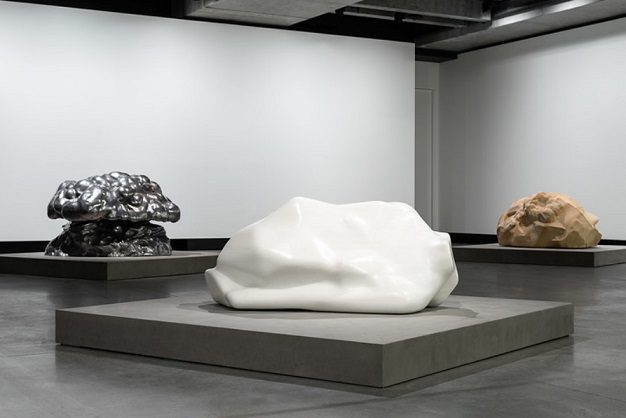 Heaven, earth, and things between—three new exhibitions are coming to Mona this September. From Jean-Luc Moulène’s long-awaited first show in Australia, to the museum’s first ever exhibition of entirely old art featuring a collection of icons, and a sensory simulation of a volcano, from musician and artist Jónsi (the one from Sigur Rós).
Heaven, earth, and things between—three new exhibitions are coming to Mona this September. From Jean-Luc Moulène’s long-awaited first show in Australia, to the museum’s first ever exhibition of entirely old art featuring a collection of icons, and a sensory simulation of a volcano, from musician and artist Jónsi (the one from Sigur Rós).
David Walsh, Mona owner and founder, says: ‘We opened three exhibitions simultaneously last year, and although it was very satisfying to cover so much ground we learnt our lesson, and we assured ourselves we would never do it again. We are doing it again. Again, we explore the vast range of the creative impulse that our biology compels. In each domain of endeavour there is that which we can learn about the motives of the artists, and that which we can learn about ourselves. The act of creation is most realised through the audience. That’d be you.’
Jean-Luc Moulène and Teams examines the relationships between material, form and the creative process; between art and industry; between artwork and observer. Acclaimed in his native France and internationally, Jean-Luc Moulène presents four newly commissioned sculptural objects at Mona—created using wax, metal, Triassic sandstone and timber from primaeval Tasmanian underwater forests. Displayed alongside a selection of earlier works that include stacks of coloured cans and a large video projection, the exhibition demonstrates Moulène’s extensive range across diverse mediums. Part of his stated process is the deliberate sharing of artistic authority. Guided by Moulène and coordinated by Michel Blancsubé and Mona’s curators, the four new sculptures have been produced in collaboration with expert ‘teams’ of Australian technicians, founders, and fabricators. Mona curator Sarah Wallace says: ‘Jean-Luc Moulène has been described as mercurial, experimental, erudite and poetic. His ideas evolve through a deep and considered engagement with material, form, and process. The resulting objects are at once mysteriously beautiful, and forthright about the means of their making.’
Heavenly Beings: Icons of the Christian Orthodox World is the first exhibition at Mona comprising only old art and the largest ever showing in Australia of jewel-like icons and related treasures. More than 140 devotional objects depicting saints, virgins and other Christian holy subjects together reveal centuries of spiritual and aesthetic tradition. Charting a journey rich in universally human emotion, the exhibition intersects with Mona’s interest in what drives behaviour and the ultimate biological motivation for things we earthbound beings do. Mona curator Jane Clark says: ‘Visitors certainly need not be religious believers to enjoy the sheer beauty and emotional power of these artworks. While painting an icon may begin from an act of piety, the resulting object also lives as a work of art far beyond its original purpose. We can look at the icon as a ‘window into heaven’, as believers believe; but also as a looking glass, through which we may glimpse the deeper purposes—deeper than awe and transcendence, than culture or a higher power—that are served by human creativity.’
Hrafntinna (Obsidian) invites visitors to encounter the cavernous depths of a volcano, created by Icelandic musician and artist Jónsi—the lead vocalist of band Sigur Rós. This is an immersive and sensory installation where the effects of music, sound and smell are experienced in near darkness. Visitors will be surrounded by almost 200 speakers emitting an array of frequencies and vibrations, along with a hymn-like composition inspired by Icelandic choral music. The artist was inspired by the volcano Fagradalsfjall which erupted in Iceland in 2021 after  lying dormant for nearly 800 years, while he was stuck in America during the pandemic. Hrafntinna (Obsidian) is the result of Jónsi’s feeling of disconnection and yearning for the lifeforce of his homeland. Mona curator Sarah Wallace says: ‘Jónsi was compelled by the thought of experiencing this incredibly rare event. He wanted to recreate the phenomenon and capture the essence of what it might feel like to be deep inside the volcano, despite the obstacles of distance and logistics.’
lying dormant for nearly 800 years, while he was stuck in America during the pandemic. Hrafntinna (Obsidian) is the result of Jónsi’s feeling of disconnection and yearning for the lifeforce of his homeland. Mona curator Sarah Wallace says: ‘Jónsi was compelled by the thought of experiencing this incredibly rare event. He wanted to recreate the phenomenon and capture the essence of what it might feel like to be deep inside the volcano, despite the obstacles of distance and logistics.’
The first iteration of the Heavenly Beings exhibition was organised and presented at Auckland Art Gallery Toi o Tāmaki, Aotearoa New Zealand, curated by Senior Curator of International Art, Dr Sophie Matthiesson. Mona has designed and published a print, hardcover edition of the accompanying catalogue, edited by Sophie Matthiesson and Gordon Morrison, complete with scholarly essays, rich illustration, maps and timelines.
Jean-Luc Moulène and Teams is curated by Michel Blancsubé with Sarah Wallace and Trudi Brinckman from Mona, and was commissioned by Olivier Varenne. A fully-illustrated catalogue that charts the production of the four new sculptures alongside a selection of essays is available from the Mona shop.
All three exhibitions will open on Saturday 30 September 2023—with a party at Mona to celebrate—and run until 1 April 2024.
















